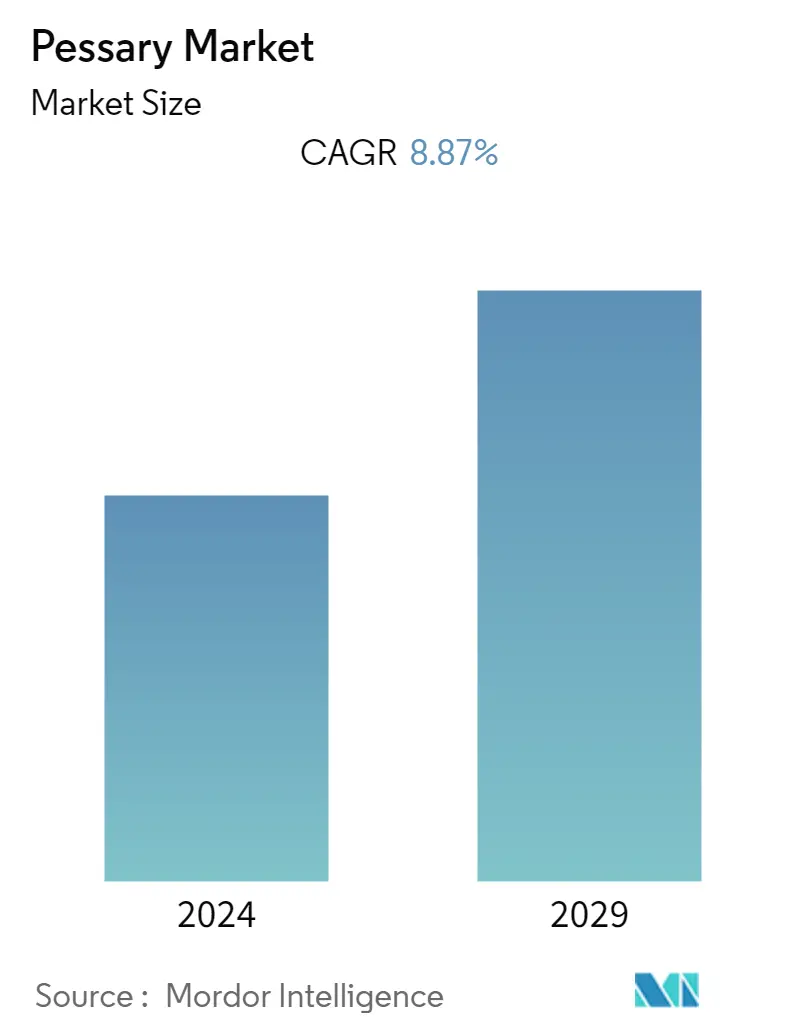Market Size of Pessary Industry

| Study Period | 2019 - 2029 |
| Base Year For Estimation | 2023 |
| Forecast Data Period | 2024 - 2029 |
| CAGR | 8.87 % |
| Fastest Growing Market | Asia-Pacific |
| Largest Market | North America |
Major Players
*Disclaimer: Major Players sorted in no particular order |
Pessary Market Analysis
The pessary market is projected to grow with a CAGR of 8.87% during the forecast period.
The COVID-19 pandemic has had a substantial impact on the growth of the pessary market owing to the significant decline in manufacturing processes, restricted demand and supply, and restricted hospital visits to avoid contact with infectious people. The industry has witnessed a negative impact as most of the population defer prosthetic surgeries due to transportation restrictions and the fear of viral infection. This has also resulted in the postponement of procedures, which included vaginal insertion of pessary as well. However, with the resumed services and prosthetic procedures, the demand for pessaries for treating various pelvic floor disorders has increased, thus the studied market has witnessed significant growth and is expected to grow over the forecast period.
Factors such as the increasing prevalence of pelvic organ prolapse, urinary incontinence in patients, increasing adoption of non-invasive treatment options, changing women's lifestyles, and a rise in the geriatric population are boosting the growth of the pessary market.
The prevalence of urinary incontinence (UI) is higher in women and elderly patients and creates a negative impact on their quality of life, which is the key factor driving the growth of the market. Urinary incontinence is becoming more common among people due to aging-related changes in the lower urinary system, including decreased bladder capacity and fullness sensation, decreased detrusor muscle contraction rate, decreased pelvic floor muscle resistance, and increased residual urine volume. For instance, according to an article published in the National Library of Medicine (NLM), in August 2022, an estimated 423 million people experience some form of UI worldwide. Similarly, according to an article published in Scientific Reports, in October 2022, it has been observed that the risk of UI increases with the first birth age, greater than 32, and decreases if the first birth occurs before age 32. Also, as per the same source, the prevalence of UI ranges between 5% to 70% during pregnancy and the postnatal period. Thus, the high prevalence of UI increases the demand for pessaries, thereby increasing the market's growth.
In addition, the increasing incidences of pelvic organ prolapse in females contribute to the pessary market's growth. The incidences of pelvic organ prolapse increase with age and after multiple pregnancies. According to an article published in Scientific Reports, in June 2022, pelvic floor disorders (PFD) which include UI, pelvic organ prolapse (POP), and bowel dysfunction (difficult defecation and anal incontinence (AI)) are common among adult women seeing in primary care settings. It has been observed that bowel dysfunction was the most prevalent PFD among women, accounting for 24.6% of all cases, followed by urine incontinence (11.1%) and pelvic organ prolapse (POP) (4.4%) in Iowa. Additionally, as per the same source, about 1.1% had all three categories of PFD, and 5.5% had precisely two PFD. Thus, the high prevalence of pelvic organ prolapse in women increases the demand for pessaries to treat pelvic organ prolapse issues in women, thereby contributing to the market growth.
Therefore, owing to the aforementioned factors, such as the high burden of urinary incontinence and pelvic organ prolapse, the studied market is anticipated to grow over the forecast period. However, patient discomfort and fear of side effects are some factors that hinder the market's growth.
Pessary Industry Segmentation
As per the scope of the report, a pessary is a soft, flexible prosthetic device inserted into the vagina for structural and pharmaceutical purposes. It is most frequently used to treat pelvic organ prolapse and stress urinary incontinence to keep organ placement in the pelvic area. It can also be used as a means of contraception or to locally administer medications in the vagina. The Pessary Market is Segmented by Type (Gellhorn, Ring, Donut, and Others), End User (Hospital Pharmacies, Retail Pharmacies, and Online Pharmacies), and Geography (North America, Europe, Asia-Pacific, Middle East and Africa, South America). The report also covers the estimated market sizes and trends for 17 countries across significant global regions. The report offers the value (USD million) for the above segments.
| By Type | |
| Gellhorn | |
| Ring | |
| Donut | |
| Others |
| By End User | |
| Hospital Pharmacies | |
| Retail Pharmacies | |
| Online Pharmacies |
| Geography | ||||||||
| ||||||||
| ||||||||
| ||||||||
| ||||||||
|
Pessary Market Size Summary
The pessary market is experiencing a robust growth trajectory, driven by an increasing prevalence of pelvic organ prolapse and urinary incontinence, particularly among women and the elderly. The market's expansion is further supported by the rising adoption of non-invasive treatment options and the growing geriatric population. Despite the initial setbacks caused by the COVID-19 pandemic, which led to a decline in manufacturing and postponed medical procedures, the market has rebounded as healthcare services resumed. The demand for pessaries, which are used to manage various pelvic floor disorders, has surged, contributing to the market's positive outlook over the forecast period. The ring pessary segment, in particular, is expected to witness significant growth due to its ease of use, patient comfort, and effectiveness in treating pelvic organ prolapse and urinary incontinence.
North America is anticipated to hold a significant share of the pessary market, fueled by an aging female population, lifestyle changes, and increased health awareness. The region's market growth is also supported by the presence of major industry players and a focus on developing innovative, non-invasive medical devices for treating pelvic floor disorders. The competitive landscape of the pessary market is characterized by numerous domestic and international players engaging in strategic activities such as product development, mergers, and partnerships to maintain their market positions. Key players include CooperSurgical Inc., MedGyn Products Inc., Panpac Medical Corporation, Integra Lifesciences, and Dr. Arabin GmbH & Co. KG, who are actively contributing to the market's expansion through advancements in product offerings and technology.
Pessary Market Size - Table of Contents
-
1. MARKET DYNAMICS
-
1.1 Market Overview
-
1.2 Market Drivers
-
1.2.1 Increasing Prevalence of Pelvic Organ Prolapse, Urinary Incontinence and Rise in Geriatric Population
-
1.2.2 Increasing Adoption of Non-Invasive Treatement Options
-
1.2.3 Rising Concern for Women's Health and Government Initiatives
-
-
1.3 Market Restraints
-
1.3.1 Patient Discomfort and Fear of Side Effects
-
-
1.4 Porter's Five Forces Analysis
-
1.4.1 Threat of New Entrants
-
1.4.2 Bargaining Power of Buyers/Consumers
-
1.4.3 Bargaining Power of Suppliers
-
1.4.4 Threat of Substitute Products
-
1.4.5 Intensity of Competitive Rivalry
-
-
-
2. MARKET SEGMENTATION (Market Size by Value - USD million)
-
2.1 By Type
-
2.1.1 Gellhorn
-
2.1.2 Ring
-
2.1.3 Donut
-
2.1.4 Others
-
-
2.2 By End User
-
2.2.1 Hospital Pharmacies
-
2.2.2 Retail Pharmacies
-
2.2.3 Online Pharmacies
-
-
2.3 Geography
-
2.3.1 North America
-
2.3.1.1 United States
-
2.3.1.2 Canada
-
2.3.1.3 Mexico
-
-
2.3.2 Europe
-
2.3.2.1 Germany
-
2.3.2.2 United Kingdom
-
2.3.2.3 France
-
2.3.2.4 Italy
-
2.3.2.5 Spain
-
2.3.2.6 Rest of Europe
-
-
2.3.3 Asia-Pacific
-
2.3.3.1 China
-
2.3.3.2 Japan
-
2.3.3.3 India
-
2.3.3.4 Australia
-
2.3.3.5 South Korea
-
2.3.3.6 Rest of Asia-Pacific
-
-
2.3.4 Middle East and Africa
-
2.3.4.1 GCC
-
2.3.4.2 South Africa
-
2.3.4.3 Rest of Middle East and Africa
-
-
2.3.5 South America
-
2.3.5.1 Brazil
-
2.3.5.2 Argentina
-
2.3.5.3 Rest of South America
-
-
-
Pessary Market Size FAQs
What is the current Global Pessary Market size?
The Global Pessary Market is projected to register a CAGR of 8.87% during the forecast period (2024-2029)
Who are the key players in Global Pessary Market?
CooperSurgical Inc., Panpac Medical Corporation, Integra Lifesciences, MedGyn Products, Inc. and Dr. Arabin GmbH & Co. KG are the major companies operating in the Global Pessary Market.

